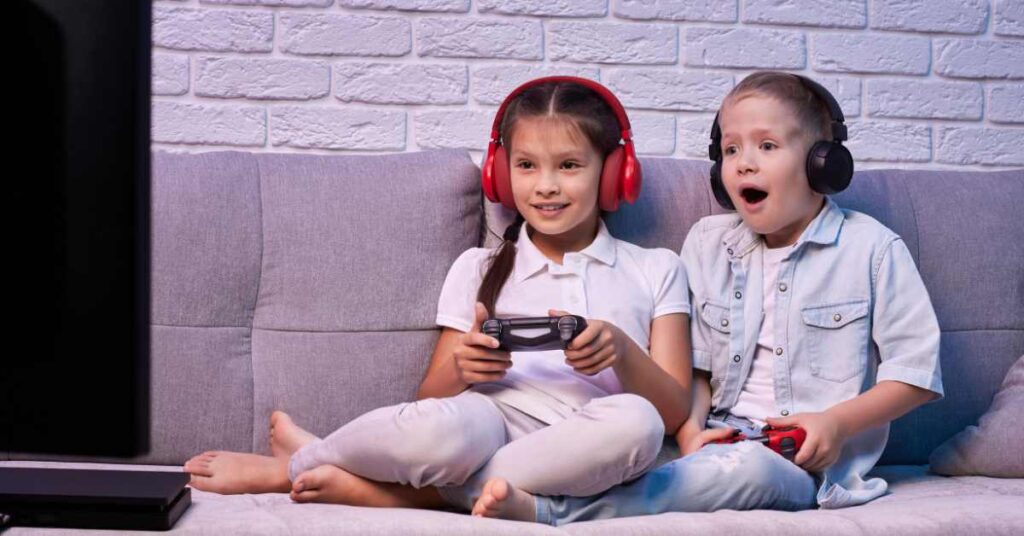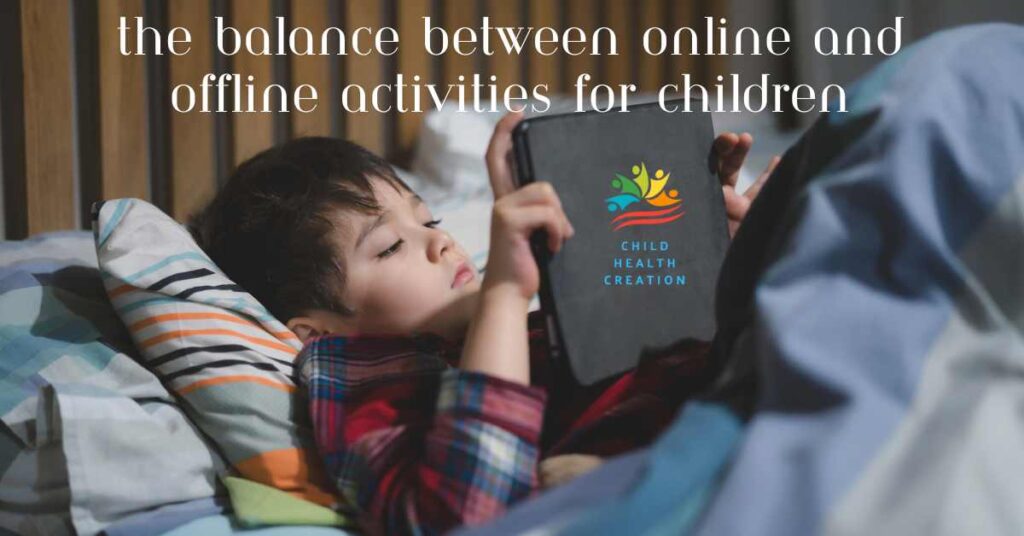Table of Contents
What parents should know? Latest scientific research data and practical takeaways for digital well-being
- Do we have to allow our children to use digital apps when they want?
- Does uncontrolled use of digital devices harm children`s health?
- How to manage screen time for children?
- Age-appropriate guidelines for Screen Time

In the modern world, one of the popular trends in the field of children`s health development is digital well-being, which takes one of the first places along with such topics as sufficient physical activity, nutrition, balanced diets, and mental health awareness.
With the rise of digital devices, there’s a trend towards managing screen time and promoting a healthy balance between online and offline activities for children.
Does uncontrolled use of digital devices harm children`s health?
Excessive or uncontrolled use of digital devices can have both short-term and long-term effects on children’s health. It’s important to note that the impact can vary among individuals, and factors such as the type of content, duration of use, and the child’s age all play a role. Here are some potential health concerns associated with uncontrolled use of digital devices:
1. Physical Health:
Sedentary Lifestyle: Excessive screen time can contribute to a sedentary lifestyle, which is associated with various health issues, including obesity and cardiovascular problems.
Posture Problems: Prolonged use of digital devices, especially without proper ergonomics, can lead to posture-related issues, such as scoliosis, kyphosis, arthrosis, joint issues and musculoskeletal problems.
2. Sleep Disruption:
Blue Light Exposure: The blue light emitted by screens, especially in the evening, can interfere with the body’s natural sleep-wake cycle, potentially leading to sleep disturbances.
3. Mental and Emotional Health:
Increased Stress and Anxiety: Exposure to certain content, cyberbullying, or excessive social media use can contribute to stress and anxiety.
Impaired Social Skills: Excessive screen time may interfere with the development of face-to-face social skills and emotional intelligence.
4. Cognitive Development:
Impact on Attention and Concentration: Uncontrolled use of digital devices, particularly in young children, has been associated with attention and concentration issues.
Delayed Language Development: Excessive screen time might limit opportunities for verbal communication and language development.
5. Behavioural Issues:
Aggression and Irritability: Exposure to violent or inappropriate content may contribute to aggressive behaviour or irritability in some children.
Difficulty with Self-Regulation: Excessive screen time can interfere with a child’s ability to regulate their emotions and behaviour.
6. Educational Impact:
Reduced Academic Performance: Excessive use of digital devices may lead to distraction and reduced time spent on educational activities.
7. Addiction and Dependence:
Screen Addiction: Uncontrolled use can contribute to problematic behaviours resembling addiction, with children becoming overly reliant on digital devices for entertainment or social interaction.
8. Risk of Cyberbullying and Inappropriate Content:
Online Safety Concerns: Lack of supervision and uncontrolled use can expose children to inappropriate content and increase the risk of cyberbullying.
9. Eye Strain and Vision Issues:
Digital Eye Strain: Prolonged screen time can lead to eye strain, dry eyes, and discomfort, collectively known as digital eye strain.
10. Privacy Concerns:
Uncontrolled use of digital devices, especially on the internet, can expose children to privacy risks if they share personal information without understanding the consequences.
Resume:
- It’s essential for parents and caregivers to be actively involved in their children’s digital lives, set reasonable limits, and encourage a healthy balance between screen time and other activities.
- Regular communication about online safety, responsible use, and the potential impacts of excessive screen time is crucial in fostering a healthy relationship with digital devices.
- Additionally, staying informed about the latest research and guidelines on screen time and children’s health is important for making well-informed decisions.
How do you manage screen time for children?
Managing screen time for children is important for their overall well-being, including physical health, mental health, and the development of healthy habits. Here are some guidelines and strategies for effectively managing screen time:
1. Set Clear Limits:
Establish clear and consistent rules regarding screen time. Clearly communicate these limits to your child and be consistent in enforcing them.
2. Follow Age-Appropriate Guidelines:
Consider following age-appropriate guidelines for screen time. Organizations like the American Academy of Pediatrics provide recommendations based on a child’s age.
3. Create Tech-Free Zones:
Designate specific areas or times in your home as tech-free zones. For example, the dining table or bedrooms can be areas where screens are not allowed.
4. Encourage Outdoor Activities:
Promote physical activity and outdoor play. Encourage your child to engage in sports, play, or other physical activities to balance screen time with healthy, active pursuits.
5. Model Healthy Behaviour:
Children often mimic the behaviour of adults. Model healthy screen time habits by demonstrating responsible use of digital devices.
6. Use Educational Content:
If your child uses digital devices, choose age-appropriate and educational content. There are many apps, games, and websites that provide educational value.
7. Set Screen Time Schedule:
Establish specific times during the day when screen time is allowed. This helps create a routine and predictability for your child.
8. Limit Social Media Use:
For older children who use social media, set guidelines for appropriate use. Discuss the potential risks and benefits of social media and monitor your child’s online activities.
9. Monitor Content:
Regularly check the content your child is accessing. Ensure that it is age-appropriate and aligns with your family values.
10. Establish Tech-Free Bedtime Routine:
Create a tech-free bedtime routine to promote better sleep. The blue light emitted from screens can interfere with sleep patterns.
11. Use Parental Controls:
Utilize parental control features on devices to restrict access to inappropriate content and manage screen time.
12. Encourage Face-to-Face Interaction:
Foster face-to-face communication and social interactions. Encourage your child to engage in conversations, play with friends, and participate in group activities.
13. Educate About Online Safety:
Teach your child about online safety, including the importance of not sharing personal information and being cautious about the content they access.
14. Set Family Rules:
Involve your child in the process of setting family rules for screen time. This can help them understand the reasons behind the limits.
15. Provide Alternatives:
Offer alternative activities that do not involve screens, such as reading, arts and crafts, playing board games, or spending time outdoors.
16. Regular Check-Ins:
Have regular check-ins with your child to discuss their screen time habits. Be open to their perspective and make adjustments if needed.
17. Be Flexible:
While it’s essential to have guidelines, be flexible and willing to adjust them based on your child’s age, needs, and developmental stage.
Resume:
Remember that the goal is to create a healthy balance between screen time and other activities that contribute to your child’s overall well-being. Regular communication, setting a positive example, and being actively involved in your child’s digital life can contribute to effective screen time management.
Age-Appropriate Guidelines for Screen Time
The American Academy of Pediatrics provides recommendations based on a child’s age.
According to the last research trends, the American Academy of Pediatrics (AAP) provides general guidelines for screen time based on a child’s age.
Here are general guidelines from the AAP:
For Children Younger Than 18 Months:
Avoid the use of screen media, except for video chatting.
For Children 18 to 24 Months:
If you choose to introduce digital media, use high-quality programming/apps and co-view with your child. Ensure that the content is educational and age appropriate.
For Children 2 to 5 Years:
Limit screen time to one hour per day of high-quality programming. Co-viewing is still recommended to help children understand what they are seeing.
For Children 6 Years and Older:
Establish consistent limits on the amount of screen time and ensure that it does not interfere with adequate sleep, physical activity, and other healthy behaviours.
Prioritize creative, educational, and interactive content.
Media-Free Zones and Times:
Designate specific areas in the home, such as bedrooms, as media-free zones.
Set regular media-free times, such as during meals and at least one hour before bedtime.
Promote Healthy Media Use:
Encourage positive and pro-social media use. Discuss online safety, cyberbullying, and the importance of being kind and respectful online.
Resume:
- It’s important to note that these guidelines are intended to provide a framework for parents and caregivers. Individual circumstances may vary, and it’s crucial to consider a child’s overall well-being, developmental stage, and individual needs.
- As the technology and media landscape continually evolves, staying informed about the latest research and recommendations is essential.
- Additionally, engaging in open communication with children about their media use and being actively involved in their digital activities are crucial aspects of promoting healthy screen time habits.
Your comments are valuable, and if you’re interested in professional child health creation services, learn more via this link.





